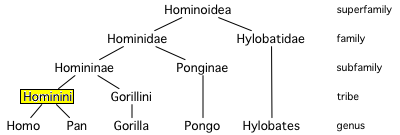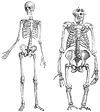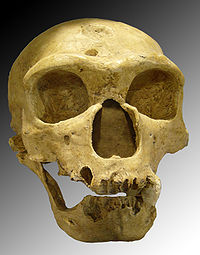Homo (genus)
Homo is the genus that includes modern humans and their close relatives. The genus is estimated to be about 2.5 million years old, evolving from Australopithecine ancestors with the appearance of Homo habilis. Appearance of Homo coincides with the first evidence of stone tools (the Oldowan industry), and thus by definition with the beginning of the Lower Paleolithic.

Extant Hominoid family tree
All species except Homo sapiens (modern humans) are extinct. Homo neanderthalensis, traditionally considered the last surviving relative, died out 24,000 years ago while a recent discovery suggests that another species, Homo floresiensis, may have lived as recently as 12,000 years ago.
A minority of zoologists consider that the two species of chimpanzees (usually treated in the genus Pan), and maybe the gorillas (usually treated in the genus Gorilla) should also be included in the genus based on genetic similarities. Most scientists argue that chimpanzees and gorillas have too many anatomical differences between themselves and humans to be part of Homo. Given the large number of morphological similarities exhibited, Homo is closely related to several extinct hominin genera, most notably Kenyanthropus, Paranthropus and Australopithecus. As of 2007[update], no taxon is universally accepted as the origin of the radiation of Homo.
The word homo is Latin for "man", in the original sense of "human being", or "person". The word "human" itself is from Latin humanus, an adjective cognate to homo, both thought to derive from a Proto-Indo-European word reconstructed as*dhǵhem- "earth"[1]. Cf. Hebrew adam, meaning "human", cognate to adamah, meaning "ground". (And cf. Latin humus, meaning "soil" and Slavic земля meaning "land, earth".)
Species
Comparative table of Homo species
| Species |
Lived when (mya) |
Lived where |
Adult height |
Adult mass |
Brain volume (cm³) |
Fossil record |
Discovery / publication of name |
| H. habilis |
2.2 – 1.6 |
Africa |
1.0–1.5 m (3.3–4.9 ft) |
33–55 kg (73–120 lb) |
660 |
many |
1960/1964 |
| H. erectus |
2 – 0.03 |
Africa, Eurasia (Java, China, Caucasus) |
1.8 m (5.9 ft) |
60 kg (130 lb) |
850 (early) – 1100 (late) |
many |
1891/1892 |
| H. rudolfensis |
1.9 |
Kenya |
|
|
|
1 skull |
1972/1986 |
| H. georgicus |
1.8 |
Republic of Georgia |
|
|
600 |
few |
1999/2002 |
| H. ergaster |
1.9 – 1.4 |
E. and S. Africa |
1.9 m (6.2 ft) |
|
700–850 |
many |
1975 |
| H. antecessor |
1.2 – 0.8 |
Spain |
1.75 m (5.7 ft) |
90 kg (200 lb) |
1000 |
2 sites |
1997 |
| H. cepranensis |
0.9 – 0.8? |
Italy |
|
|
1000 |
1 skull cap |
1994/2003 |
| H. heidelbergensis |
0.6 – 0.25 |
Europe, Africa, China |
1.8 m (5.9 ft) |
60 kg (130 lb) |
1100–1400 |
many |
1908 |
| H. neanderthalensis |
0.35 – 0.03 |
Europe, W. Asia |
1.6 m (5.2 ft) |
55–70 kg (120–150 lb) (heavily built) |
1200–1700 |
many |
(1829)/1864 |
| H. rhodesiensis |
0.3 – 0.12 |
Zambia |
|
|
1300 |
very few |
1921 |
| H. sapiens sapiens |
0.2 – present |
worldwide |
1.4–1.9 m (4.6–6.2 ft) |
50–100 kg (110–220 lb) |
1000–1850 |
still living |
—/1758 |
| H. sapiens idaltu |
0.16 – 0.15 |
Ethiopia |
|
|
1450 |
3 craniums |
1997/2003 |
| H. floresiensis |
0.10 – 0.012 |
Indonesia |
1.0 m (3.3 ft) |
25 kg (55 lb) |
400 |
7 individuals |
2003/2004 |
Species status of Homo rudolfensis, H. ergaster, H. georgicus, H. antecessor, H. cepranensis, H. rhodesiensis and H. floresiensis remains under debate. H. heidelbergensis and H. neanderthalensis are closely related to each other and have been considered to be subspecies of H. sapiens, but analysis of mitochondrial DNA from Homo neanderthalensis fossils shows that H. neanderthalensis is genetically closer to chimpanzees than H. sapiens is, thereby suggesting that H. sapiens is the more derived of the two.[2]
References
- Serre et al. (2004). "No evidence of Neandertal mtDNA contribution to early modern humans". PLoS Biology 2 (3): 313–7. doi:10.1371/journal.pbio.0020057. PMID 15024415.
External links
|
Part of the series on Human evolution |
|
|
|
| Hominini |
|
Sahelanthropus tchadensis • Orrorin tugenensis • Ardipithecus • Kenyanthropus platyops
|
| Australopithecines |
|
Australopithecus: A. anamensis • A. afarensis • A. bahrelghazali • A. africanus • A. garhi
Paranthropus: P. aethiopicus • P. boisei • P. robustus
|
| Humans and Proto-humans |
|
Homo: H. habilis • H. rudolfensis • H. georgicus • H. ergaster • H. erectus (H. e. lantianensis • H. e. palaeojavanicus • H. e. pekinensis • H. e. soloensis) • H. cepranensis • H. antecessor • H. heidelbergensis • H. neanderthalensis • H. rhodesiensis • H. floresiensis • H. sapiens (H. s. idaltu • H. s. sapiens)
|
| Topics: Timeline of human evolution • List of human evolution fossils • Human evolutionary genetics |
|
|
Extant species of family Hominidae (Great apes) |
|
| Kingdom: Animalia · Phylum: Chordata · Class: Mammalia · Order: Primates · Suborder: Haplorrhini |
|
| Ponginae |
|
|
Bornean Orangutan (P. pygmaeus) · Sumatran Orangutan (P. abelii)
|
|
|
| Homininae |
|
|
Western Gorilla (G. gorilla) · Eastern Gorilla (G. beringei)
|
|
|
|
|
|
|
Homo
|
|
|
|
| Category |
|
|
Ape-related articles |
|
| Ape study |
|
 |
|
| Legal status |
Personhood · Research ban · Declaration · Kinshasa Declaration · Great Ape Project · Survival Project
|
|
| See also |
|
|

